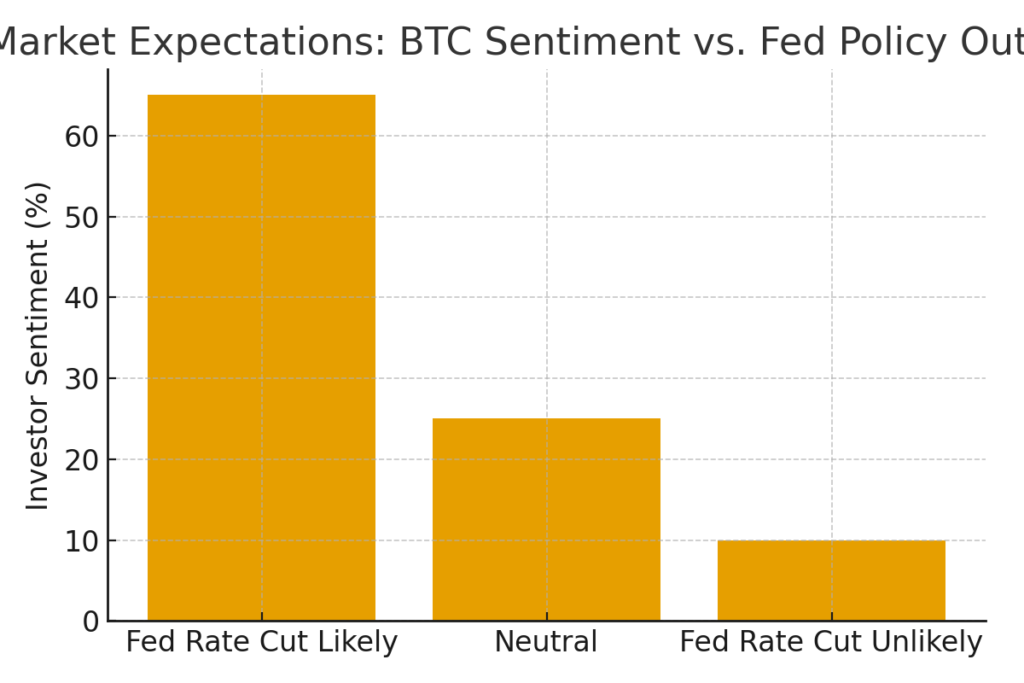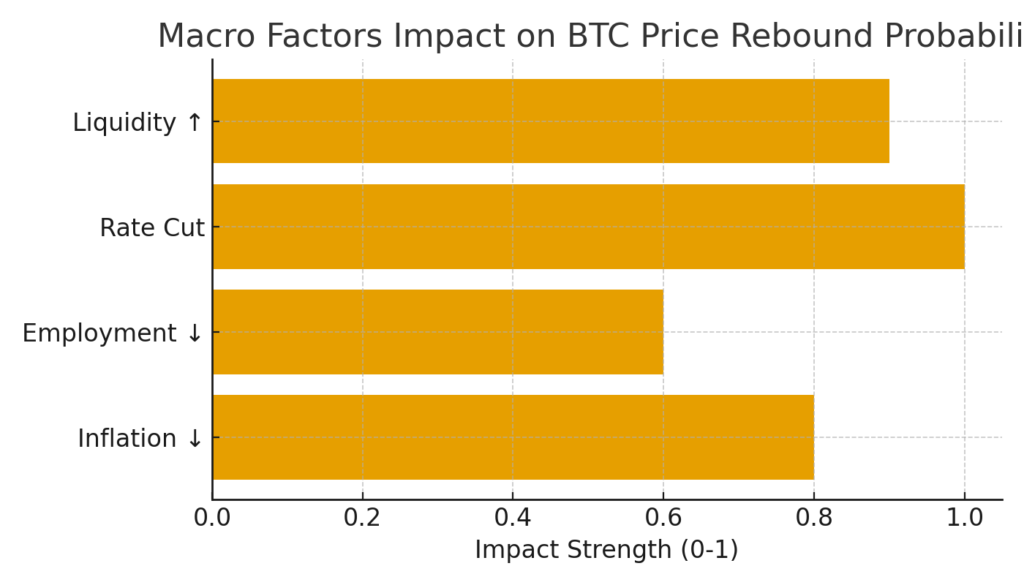
Main Points :
- Technical indicators suggest Bitcoin has reached oversold territory, hinting at a potential rebound.
- Key macroeconomic data and upcoming policy decisions by the Federal Reserve (Fed) will be decisive for market sentiment and risk-asset flows.
- The convergence of technical signals and monetary-policy shifts marks a critical inflection point for Bitcoin’s near-term trend.
- Investors should prepare strategies for multiple scenarios — a sharp reversal or further downside — as the market stands at a major crossroads.
1. Technical Signals Indicate “Oversold” Conditions and Rising Rebound Pressure

Technical charts for Bitcoin are flashing caution and opportunity. Recent RSI (Relative Strength Index) readings show that Bitcoin is in a “sold-too-much” zone. For example, one report noted the BTC/Gold ratio’s RSI dropped to circa 22.2 — the lowest since November 2022 — signalling deep oversold conditions. Another data set shows Bitcoin’s RSI at ~40.7, indicating persistent downside pressure but still possible for a rebound.
When an asset becomes oversold, it means the sell-off has outpaced underlying value or sentiment to such an extent that a reversal becomes increasingly likely. The technical pattern here suggests that internal momentum is starting to accumulate — the “buying pressure” from traders who believe the downside is exhausted could build.
For short-term traders especially, this is an alert that the market may be primed for a bounce. The RSI is only one tool, but the supporting technical setup (narrowing Bollinger Bands, accumulated volume, consolidation near support) suggests that Bitcoin may be nearing a short-term bottom.
However, caution is required: oversold readings don’t guarantee an immediate reversal. The price could linger or even dive further if macro conditions worsen or if support breaks. But from a tactical perspective, the technical backdrop is now favourable for a potential trade setup.
2. Macro-economic Focus: Upcoming Indicators Hold the Key to Rate-Cut Expectations

While the technicals are bringing attention, the macro backdrop is the engine that may drive the next leg of Bitcoin’s move. The market is closely watching upcoming U.S. economic indicators — inflation, employment, GDP — because they feed directly into expectations about Fed policy.
Bitcoin has increasingly behaved like a “risk asset” sensitive to liquidity conditions. Lower interest rates and looser monetary policy tend to boost its appeal: when real yields decline, alternatives like Bitcoin become relatively more attractive.
If inflation cools and employment softens, the case for a Fed rate cut becomes stronger. That outcome could act as a catalyst: the expectation of easier monetary policy might drive fresh inflows into Bitcoin and risk assets. On the flip side: if inflation spikes or employment remains strong — implying the Fed must stay hawkish — then Bitcoin could suffer from reduced liquidity and heightened risk aversion.
Moreover, the market is paying attention not just to the event of a rate cut but to timing, magnitude, and signalling of future policy. For example, one report notes that more than 56 % of traders expect a Fed cut to 3.5 %–3.75 % in December, yet renewed trade tensions may dampen that expectation.
In short: the macro-environment is volatile and critical. Investors looking at Bitcoin as a potential next-income source or new asset should monitor macro flows, central-bank messaging, and data releases. A favourable release may trigger strong momentum; an unfavourable one risks sending Bitcoin lower.
3. The Crucial Intersection: Technical Oversold + Rate-Cut Expectations = Major Decision Point

The real intrigue lies where the technical and the macro meet. We are now at an inflection point where:
- Bitcoin technicals suggest a possible reversal (signalled by oversold RSI, consolidation, support levels).
- Simultaneously, market expectations for easier monetary policy are hanging in the balance.
If both align — i.e., oversold conditions + confirmed path to rate cuts — then Bitcoin could enjoy a strong upward move as risk-assets regain favour and liquidity pours in. This would be a near-ideal “backdrop meets setup” scenario.
Conversely, if macro surprises to the upside (inflation strong, hawkish Fed) and the technical supports fail, the reversal may not happen — and instead, the price might drift downward further. Hence the two forces form a “double-check” for investors and traders.
This dual perspective (technical + fundamental) raises the bar for decision-making. Relying on either one alone carries higher risk. Using both gives a higher degree of confidence.
From an execution perspective:
- Scenario A (bullish): If a favourable macro print emerges, and Bitcoin breaks above key resistance (say around US $ 113,000–US $ 115,000), then a rebound toward US $ 120,000+ becomes a realistic target.
- Scenario B (bearish): If macro data disappoints and Bitcoin breaks support (US $ 100,000–US $ 105,000), then further downside becomes probable — short-term traders may look to risk-manage aggressively.
Strategic preparation is therefore essential.
4. Strategic Readiness: How to Position for Multiple Outcomes
Given the market’s cross-currents, the prudent approach is to prepare for multiple possible outcomes. Traders and investors aiming to discover new crypto assets, income opportunities or blockchain use-cases should consider:
a) Risk-Reward Mapping
Define clear support and resistance levels (e.g., US $ 100 k–US $ 105 k support zone, US $ 113 k–US $ 115 k resistance zone). Consider stop-losses if support breaks. Consider profit-targets if resistance fails.
b) Staggered Entry or Tiered Positions
If Bitcoin shows early signs of reversal (positive macro, strong technical bounce), consider scaling in. If not, hold off. This strategy may allow participation in a rebound while limiting downside.
c) Monitor Macro-Triggers Closely
Key data releases, Fed speeches, global risk-events (trade tensions, geopolitics) may act as triggers. Have alerts in place.
Also monitor on-chain data (accumulation, flows into ETFs, institutional positioning) to gauge structural strength. For example, some reports show institutional buying and renewed ETF flows supporting Bitcoin around the US $ 110 k level.
d) Consider Adjacent Opportunities
While Bitcoin remains the anchor asset, new crypto assets and blockchain projects may respond to the same macro- and technical-forces. If Bitcoin begins to rally, risk-assets (altcoins, DeFi tokens) may follow — but they carry higher risk, so due diligence is required.
If Bitcoin fails, risk-assets may suffer more sharply. Hence, allocation to these should be laddered and risk-managed.
5. Additional Context: Institutional Flows, ETF Adoption, and Broader Trends
Beyond purely technical and macro lenses, there are structural changes in the crypto market worth noting. The rise of spot Bitcoin ETFs and institutional adoption has shifted Bitcoin’s behaviour: it is less a fringe speculative asset and more a component of mainstream portfolios.
Such structural factors provide additional “support” for Bitcoin’s future, but they also raise the stakes: when you have institutional flows and macro-sensitivities, the price may move faster and harder in either direction.
Also, the broader crypto market cap recently sits around US $ 3.71 trillion — indicating that despite Bitcoin’s fall, it remains a massive asset class with meaningful investor interest.
For someone seeking new crypto assets or income opportunities, this means:
- Entry timing matters. The next wave may correlate with macro shifts.
- Structural tailwinds (ETF adoption, institutional money) may outlast short-term noise.
- But risk remains elevated: macro-shock, regulatory surprise, or tech breakdown could derail momentum.
6. Conclusion: The Big Picture and What Comes Next
In sum, this coming week is a turning point for Bitcoin and risk assets more broadly. On one side, technical indicators are flashing a potential rebound: oversold readings, consolidating price action, and support levels holding. On the other, the macro-environment is poised for a directional move, with upcoming data and Fed policy acting as the trigger.
For investors hunting new crypto assets or seeking additional income sources, this is a moment to sharpen focus, manage risk, and prepare. If the macro tide turns positive and technical supports hold, Bitcoin could rally — offering a meaningful opportunity. But the reverse is equally plausible: a hawkish surprise or loss of support could result in further downside.
Therefore, the strategy isn’t “buy and forget” — it is “watch, prepare, act” depending on which scenario unfolds. Entry, risk-management, and scenario planning become critical. The convergence of technical and fundamental forces means that the next move may be swift and sizeable.
For the blockchain-practical user, this means: watching Bitcoin’s move is not just about the asset itself — it is about risk-appetite, liquidity flows, and how crypto fits into the broader financial ecosystem. The week ahead may decide whether Bitcoin resumes its role as a liquidity-driven risk-asset rally or whether it retreats into consolidation or correction.
Keep your eyes on those technical levels, monitor the macro data, and ready your strategic plan — because this may be the week your next crypto-opportunity presents itself.

